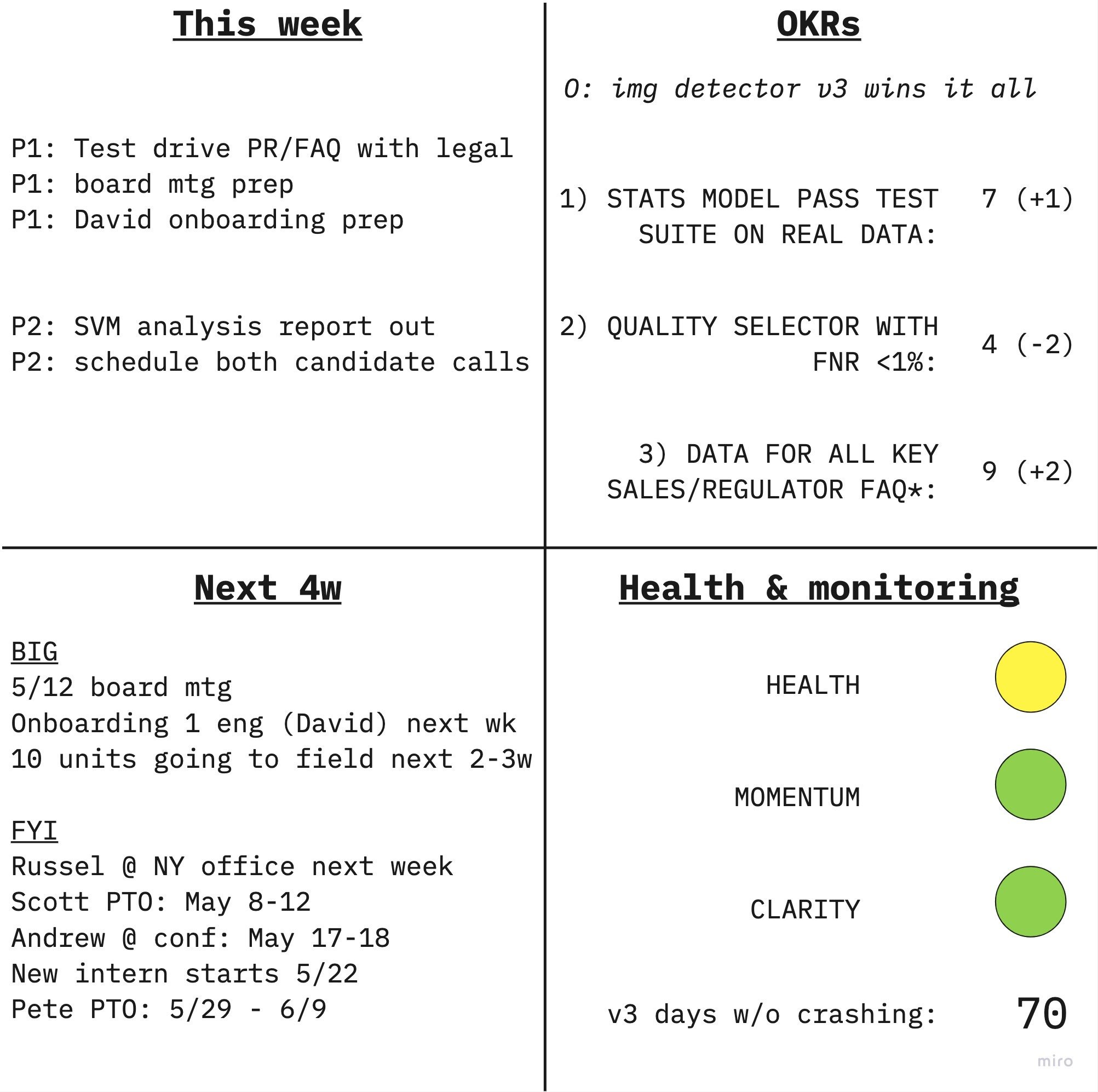A simple template to track your OKRs
Ah, nothing like the feel of a fresh new quarter. Reminds me of the clean slate feeling back in high school after report cards went out. Lots of learning from last quarter and a fresh crack at things! Exciting. …or, you might think the above sounds insane, and you’re dreading this new quarter. I know that feeling too.
Regardless, here we are: Q2. After zooming out to turn over the quarter, we all dive back into the weeds right away. Hopefully by now your team is working on your new OKRs and already setting up new experiments.
How can you track the work and keep a sense of perspective amid the fray?
99.5% of teams don't need fancy OKR software. They need a simple tool they will actually use every week.
Enter: the OKR and team health dashboard.
Q1 dashboard (redacted)
My quarterly OKR and team health dashboard
Several friends and coaching clients have pushed me to share how I keep track of work through the quarter. I built up and iterated this template over several years in operational roles and used it to lead significant bodies of work. It was the backbone of weekly team meetings. I use it for my own business now.
You don’t need fancy tools. You do need a method, and to get into a rhythm.
This template combines what I consider the best-in-class approaches to OKRs / team health, risk tracking, and continuous discovery.
Seeing it all in one place is very revealing of patterns. For example: in the chart above, you can see my health metrics are red/yellow in the start of the quarter. Tracking health metrics alongside OKRs made it clear my starting approach wasn’t sustainable. I also learned that for me personally, there’s a two week buffer, where my results fall off a cliff if I don’t take care of myself for two weeks, and then it takes me a week to recover.
Here’s a quick walkthrough of the template and links to supporting resources.
Section one: OKRs
My go-to resource to get started with OKRs is the book Radical Focus by Christina Wodtke. She and I also collaborated on this podcast discussion about how to build and lead empowered teams.
There are two main points I want to emphasize about OKRs: the cadence, and what OKRs really do.
The essence of OKRs: empowerment acceleration
OKRs do not create empowerment, they accelerate it.
By “empowerment,” I mean two factors that differentiate truly empowered teams from feature teams: (1) being accountable to produce results, and (2) having autonomy to define the solution (within the constraints of the business).
In a company that has its act together—vision, strategy, empowerment, psychological safety—OKRs formalize and amplify the empowerment and creativity that’s already there. OKRs in a poorly run company will act as a canary in the coal mine to expose what’s wrong, especially a lack of empowerment.
What unlocks OKR magic: the cadence
Cadence: as Wodtke’s books emphasize, it is all about the cadence. What really unlocks the magic of OKRs is the cadence of set-monitor-learn that she recommends.
Yes, your performance on any one quarter of OKRs is important and you’ll grade them accordingly. But the real power of OKRs is compound learning over time. You unlock this through the retrospective and narrative you develop about why the results were what they were.
My template is built on the OKR approach from Radical Focus:
one inspiring objective, three key results
rate your confidence level 1-10 weekly, discuss why it’s shifting
track team health as well to make sure you don’t burn people out
For each OKR, in addition to tracking confidence, I track the target/actual results to date (if appropriate). I added on a section at the bottom to track other KPIs that you’re going to want to anyway. I have organized these KPIs by which of the five parts of any business that they correspond to.
How to fold OKRs into your weekly team meeting
Note: the overall OKR tracking spreadsheet is often overwhelming for the weekly team meeting.
For the weekly team meeting, I usually lead with Wodtke's OKR 4square. It’s a simple 2x2, where the boxes—starting top left, going clockwise—are:
key actions this week (no more than 3 P1s)
OKRs confidence levels + WoW ∆
health metrics (stoplight grading)
upcoming 4w, key things team should be aware of
Here’s an example 4square, which makes it easy to “walk the board” in a team meeting for a current snapshot.
Example 4square: mid-quarter (early May). Team is on track, but kinda tired.
I use the larger sheet as a management tool for myself and team leads. Of course, bring it out as needed to share the zoom-out view with the team, stakeholders, show trends etc. But for the weekly meeting, the 4square feels like the right level of detail.
Section two: Risks dashboard
Whatever you’re building, it has risks. The template includes a second tab to articulate those risks and rank them by severity. I got the idea of folding-in a prioritized risks dashboard from Giff Constable.
Example risks dashboard
Section three: Discovery cadence
Whatever the risks are, hopefully you are unpacking them into testable assumptions and running experiments to learn. That’s what the third tab is all about.
Tracking the cycle time between key activities and the insights they generate—especially as they address your key risks, from tab two—represent the cadence and speed of your learning loop.
How fast is your learning loop?
That’s it! Grab your copy of the template here (make a copy), fill in your info, and most importantly: use it every week (remember the cadence!).
If you have any questions about this article, or are interested in exploring how to apply OKRs to to align and build momentum with your product teams, please reach out. Happy to help.




